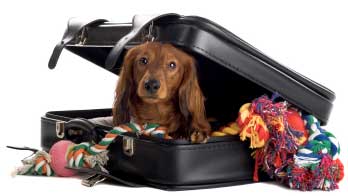Pet Air Travel
A Pet Air Travel isn't reccommended if not really needed. Travelling by plane is stressful for your pet and it should be done only if you do not have an alternate way to transport it.
Most of the times, an air travel with your pet is needed in case of relocating. In this case you can do it by yourself or contact a company which offers this service.
Not all airlines accept pets for travel. Be sure to organize it in advance. Take care of preparing all documents needed such as health certificates and other. Check with your airline what is needed, especially if you are going abroad. |  |
You have three choices for your pet air travel: together with you, inside a carry-on kennel or in a cargo shipment. In the first case your pet must be small because the carrier must fit under a passenger seat and it must remain in the carrying case throughout the entire flight.
A second choice offered by many airlines for an air travel with pet is as “accompanied baggage”, where yor pet travels in the cargo hold alongside your checked luggage. In this case the airlines allow you to transport your pet as accompanied baggage only when you are a passenger traveling on the same flight as your pet.
The third choice for a pet air travel is in a cargo shipment as live animal. You can use common cargo channels or use a special expedited delivery service delivered by most airlines. They travel in the same pressurized holds as those in the checked-in baggage. Read more about Pet Transportation Services...
Even if Pet Air Travel isn't recommended, but it doesn't mean the airlines do not care about. They are very careful even if the Humane Society of the United States recommends that you do not transport your pet by air unless absolutely necessary. Here you have their words: "Based on reports we receive from fellow owners, animals continue to be killed, injured, or lost on commercial flights each year. They can face risks including excessively hot or cold temperatures, poor ventilation, scarcity of oxygen, and rough handling when flown in the "cargo" area of a plane."
What to do then? Do what you can do to prevent it by following these guidelines:
1. Use direct flights. Avoid as much as possible connections that would make the trip longer;
2. Try to match things to fly both with the same flight. In this case you can notify the captain - even if he may already know it - and they may have extra care. It happens! Check the two stories of mine:
| A friend of mine who is a captain and has dogs, uses to leave the doors where the dogs travel opened as long as possible to assure a better air quality for the travelling animals. Usuallly the captain receives a report about what is carried and being carried on his plane/flight. |
| When I was bringing my dog in Italy, during a domestic flight, I heard the attendants talking about a dog and asked them if everything was ok as the dog was mine. They said:"Sure! Your dog is travelling on the first seats, if you want you can seat aside!" There was a coffin in that flight and alive animals cannot travel together. |
3. Buy your travel kennel at least one month before the flight (there are many cheap dog kennels available on the Internet). Leave it opened so that your pet can feel confidence with it. Experience leaving it inside it with the door closed for short periods.
4. Avoid any kind of collars that can get caught in carrier doors.
5. Have its nails clipped to avoid their hooking in the carrier's door or anything else.
6. Do not feed it 5 to 6 hours prior to air travel.
7. Avoid shipping brachycephalic animals such as Pekingese, Bulldogs, or Persian cats in the cargo holds. These breeds have short nasal passages that leave them especially vulnerable to oxygen deprivation and heat stroke.
8. Avoid temperature extremes. Early or late flights are colder during winter and afternoon flights are too hot during Summer.
9. Last but not least, decide together with your veterinarian if it is better to sedate your pet or not. Usually it is not advised as the effects of tranquilizers on animals at higher altitudes are unpredictable. In my case it worked well. I gave a small quantity before the flight (it was a 14 hours long flight) and my dog was in great shape when we took him back in Milan.
A good idea is to find the best pet health insurance for your case. It allows you to take it to a local veterinarian if you think he suffered the trip and wants it to feel good again.




